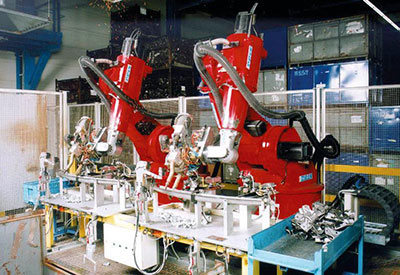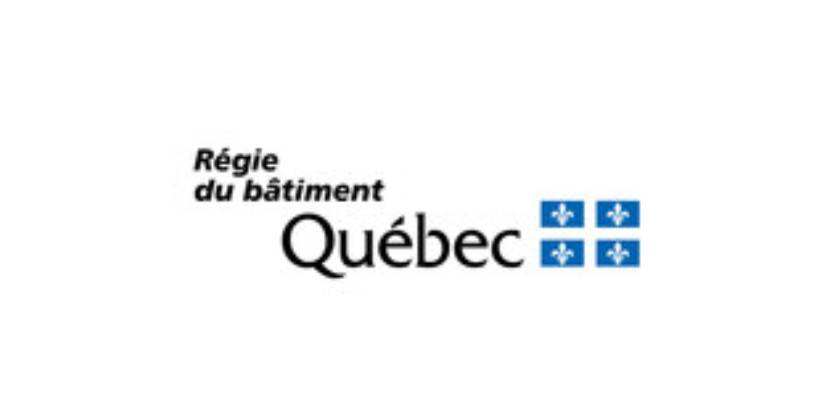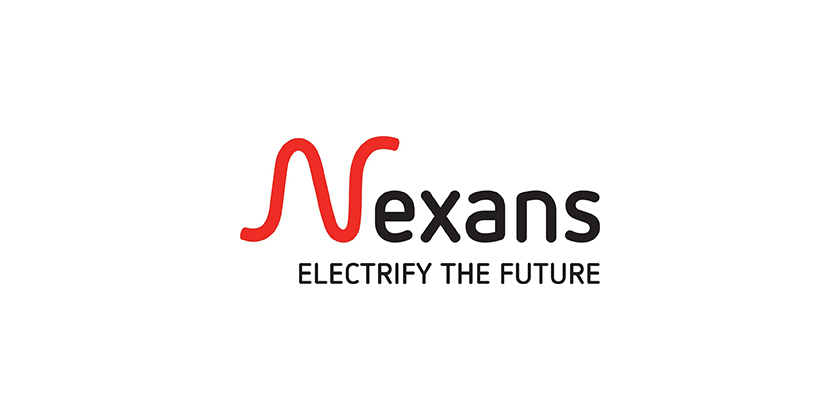La prochaine vague en architecture favorisera l’intégration des panneaux photovoltaïques aux structures des bâtiments
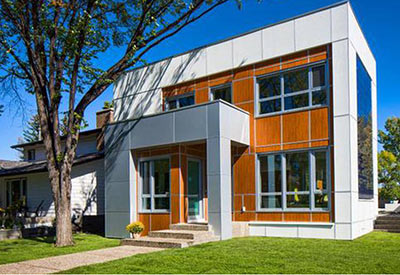
La plupart d’entre nous associent l’énergie solaire avec de grands panneaux accrochés sur les toits. Mais une nouvelle génération de bâtiments durables intègre la technologie dans la structure des édifices.
«Quand j’ai commencé, il fallait être un peu guérilla pour faire avancer les choses avec le photovoltaïque», explique Anthony Pereira, fondateur de altPOWER basée à New York, qui a commencé à travailler dans la ville en 2001 sur l’un des premiers bâtiments américains équipé avec le photovoltaïque intégré au bâtiment (BIPV). Maintenant, la technologie est en train de prendre son envol dans le monde entier.
Dans sa forme la plus simple, un panneau BIPV est un sandwich, généralement avec des cellules solaires entre deux couches de verre, qui produit de l’électricité propre. Contrairement aux panneaux de toit, les panneaux BIPV sont intégrés dans les façades extérieures du bâtiment, des surplombs et ailleurs, en remplacement des matériaux comme le béton, la brique et le bois.
Lire l’article …
Most of us identify solar power with big panels hooked on to rooftops, but a new generation of sustainable buildings is incorporating the technology into the edifices’ structure.
“When I started, you had to be a little guerrilla to get things done with photovoltaics,” says Anthony Pereira, founder of New York-based altPOWER, who started work in the city in 2001 on one of the U.S.’s first buildings outfitted with building-integrated photovoltaics (BIPV). Now, the technology is taking off around the globe.
In its simplest form, a BIPV panel is a sandwich, usually with solar cells in between two layers of glass, that produces clean electricity. Unlike rooftop panels, BIPV panels are integrated into the building’s exterior facades, overhangs and elsewhere, replacing materials like concrete, brick and wood.
BIPV use has grown in Europe and is gaining traction in North America, with Transparency Market Research predicting international growth of 19 per cent between 2013-2019.
Here are three innovative Canadian projects in which integrated solar panels have been put to work.
1. Residence, Calgary, AB
The home in a Calgary suburb features about 17 square metres of frameless, translucent, 190-watt solar modules installed on the home’s south-facing wall.
The grid-connected BIPV panels do double-duty: they draw fresh air into the home year-round, heating the air in the winter while also generating 2.3 kW of electricity, about 30% of the house’s requirements. On occasions when the panels are producing more electricity than needed, the excess is exported to the grid, says David Vonesch, an engineer and partner in Calgary-based SkyFire Energy, the company that installed the BIPV.
Two years ago, it cost about $13,000 for the home’s BIPV. Today, a similar system costs about $11,500, Vonesch says. While more expensive than roof solar panels, BIPV panels use heavier glass and should last a decade past the typical 25-year warranty, says Vonesch. ”We’ve installed more BIPV in 2014 than our 13 previous years combined,” he adds.
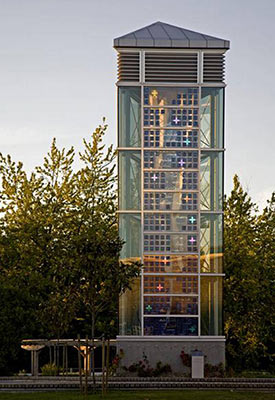 2. Regent College, Vancouver, BC
2. Regent College, Vancouver, BC
At Regent College, the University of British Columbia’s theology school, a tower that delivers fresh air and natural light to an underground library has seamlessly married BIPV with coloured glass.
The 12-metre tall, triangular True North tower features, on the south face, a 1.8 by 7.3-metre vertical collage, the first permanent installation in North America to integrate stained glass and BIPV. In 2007, Canadian glass artist Sarah Hall designed 12 panels where the BIPV sections are arranged on an open grid with the collage visible throughout the glass.
The German-made panels, featuring biblical scripture, are 2.5-centimetres wide, says Brad McTavish, of Grout McTavish Architects, the Vancouver firm that designed the tower. Each panel contains a glass layer, then photovoltaic components, then dichroic (changing colour) glass, followed by an air space for cushioning and, finally, the outer stained glass.
The True North tower’s role is to draw air and light down to the below-grade library where precious books are housed. In a clever arrangement, electricity for the fan that moves air down to the library is produced at the tower’s BIPV south face. ”It sets a new paradigm on how to create a LEED Gold building while introducing artistic architecture,” McTavish says.
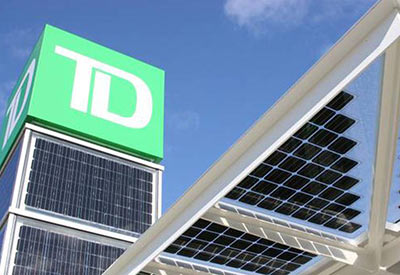 3. TD Bank, Mississauga, ON
3. TD Bank, Mississauga, ON
Last fall, Toronto’s Eclipsall Energy Corp. completed its first BIPV installation, a new TD Bank branch in Mississauga.
Eclipsall custom-made 30 frameless, glass-on-glass photovoltaic panels that serve as a street-level, marquee-like canopy along the bank’s south facade. Several BIPV modules were also incorporated into the curtain wall tower at the top of the bank. The use of BIPV, in tandem with other green technologies, has helped the TD branch earn a LEED Platinum rating, the highest.
Eclipsall’s work on the ambitious project began early. ”BIPV starts at the architectural level,” says Mikael Niskanen, Vice-President, Operations. ”It has to be planned with the building envelope.”
Eclipsall got its start with solar technology but since taking a shine to BIPV, spent about 18 months and 65 trials coming up with the ideal PV module. The company uses a bifacial cell where both sides collect light. The solar cell is encapsulated on both sides by material that is itself surrounded by glass, creating a five-layer product.
Adapted from an article was produced by The Globe and Mail in consultation with GE.






